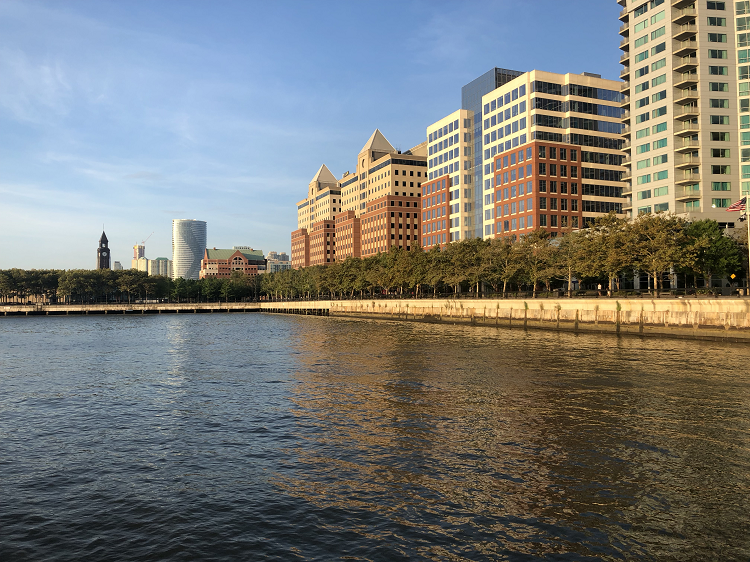Rebuild by Design Hudson River Project
Project Description
In order to address the need for increased resiliency within the Superstorm Sandy-affected region, a comprehensive urban water strategy was developed for Hoboken, Jersey City and Weehawken. This strategy included hard infrastructure and soft landscape for coastal defense, policy recommendations and guidelines, urban infrastructure to slow storm water runoff, green and grey infrastructure improvements to allow for greater storage of excess rainwater, water pumps and alternative routes to support drainage. The Hudson River Rebuild by Design (RBD) plan was selected in the first round of RBD grants and HUD awarded $230 million to the State of New Jersey for the Hudson River Project; Resist, Delay, Store, Discharge project. An Environmental Impact Statement (EIS) was prepared, in which three Build alternatives were evaluated, in addition to the No Action Alternative, in accordance with the National Environmental Policy Act (NEPA). Paul Carpenter Associates, Inc. (PCA) performed noise, air quality and greenhouse gas assessments within Technical Environmental Studies (TES) for each discipline and the respective sections of the NEPA EIS document.
In preparation of the noise assessment, PCA conducted background noise monitoring in 15 locations within the study area. An operational noise analysis was performed for each of the three proposed pump stations to determine statewide noise control code (N.J.A.C. 7:29) compliance of emergency generators during routine testing.
Due to the long-term duration of construction activities to construct project elements, construction noise and vibration analyses were also performed for all three alternatives under consideration. The noise analysis was performed utilizing the Federal Highway Administration's (FHWA) Roadway Construction Noise Model (RCNM) version 1.1, and detailed noise impacts and durations of impact to schools, libraries, places of worship and recreational areas for each proposed alternative were identified. Due to the lack of available standardized construction noise impact criteria, the FHWA's Noise Abatement Criteria were utilized to determine impact to sensitive sites with primarily daytime use when construction was slated to occur, including schools, libraries, places of worship and recreational areas.
The construction vibration assessment was performed in accordance with Federal Transit Administration procedures for General Construction Vibration Assessment due to proposed vibratory sheet pile driving and impact pile driving activities. The construction vibration assessment was performed for all three alternatives under review. Construction vibration annoyance and the potential for structural damage were evaluated. Recommended noise control measures for both construction noise and vibration were detailed within the Noise and Vibration TES.
Due to the presence of endangered species such as sturgeon (Atlantic and shortnose) within the Hudson River, a hydroacoustic analysis was performed for each alternative as a result of impact pile and vibratory sheet pile driving. Since the project was located within the National Marine Fisheries Service (NMFS) Greater Atlantic Regional Fisheries Office (GARFO) region and within nearshore of the Hudson River, the NMFS in-house screening tool for assessing potential effects to listed species exposed to underwater sound from impact and vibratory sheet pile driving was utilized. Injury and behavioral disturbance thresholds were utilized to assess impact.
As a result of the O3 nonattainment, as well as CO and PM2.5 maintenance status of the study area, operational air emissions associated with operation of the emergency generators at the three proposed pump stations were estimated. USEPA's NONROAD2008a within MOVES2014a was utilized to obtain generator emission rates. Resultant emissions were compared with applicable de minimis thresholds, pursuant to 40 CFR 93.153. In addition, air emissions associated with long-term construction activities were quantified based on each calendar year of construction utilizing USEPA's MOVES2014a/NONROADS2008a model for CO, NOx, VOC, and PM2.5. Predicted emissions for each alternative were compared to de minimis thresholds. Air quality control measures to minimize air emissions were detailed within the air quality TES. A detailed greenhouse gas emissions analysis (CO2e) was also performed for each calendar year by alternative for emergency generator operation and construction activities.
Air emissions analyses were provided within the Air Quality Technical Environmental Study (TES) while noise, vibration and hydroacoustic analyses were detailed within the Noise and Vibration TES. Both submittals were provided to support the NEPA Environmental Impact Statement (EIS) document.
